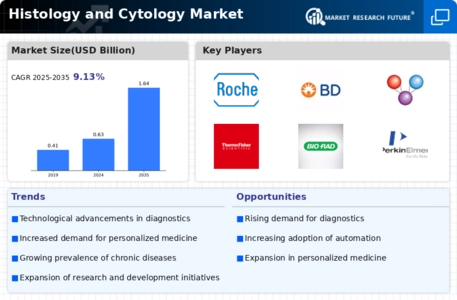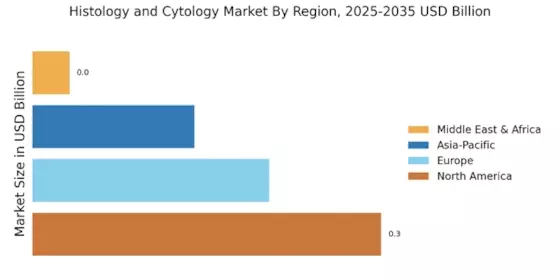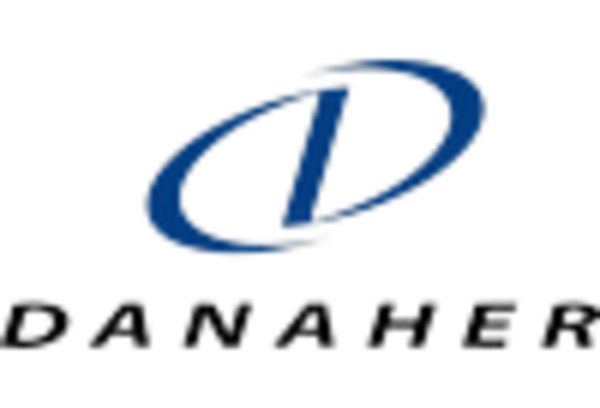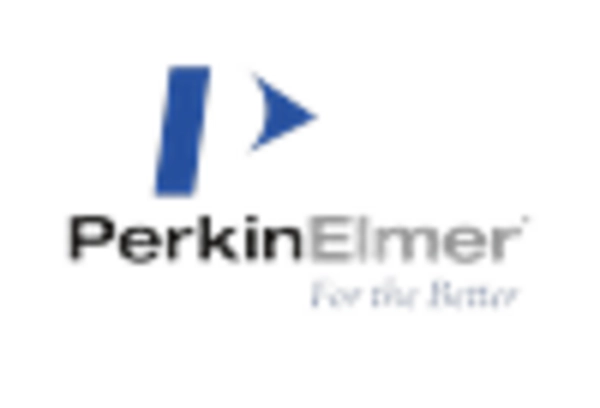Growing Focus on Early Detection
The increasing focus on early detection of diseases is a pivotal driver for the Histology and Cytology Market. Early diagnosis is essential for improving patient outcomes, particularly in oncology, where timely intervention can significantly alter prognosis. The market for cancer diagnostics, which heavily relies on histological and cytological techniques, is projected to reach USD 20 billion by 2025. This surge is attributed to heightened awareness and screening initiatives aimed at identifying malignancies at their nascent stages. As healthcare systems prioritize preventive measures, the demand for histological and cytological services is expected to rise, thereby fostering growth within the Histology and Cytology Market.
Rising Incidence of Chronic Diseases
The escalating incidence of chronic diseases is a critical factor propelling the Histology and Cytology Market. Conditions such as cancer, cardiovascular diseases, and autoimmune disorders necessitate comprehensive diagnostic evaluations, which often involve histological and cytological examinations. Recent statistics indicate that cancer cases are projected to increase by 30% by 2030, underscoring the urgent need for effective diagnostic solutions. This trend is likely to drive demand for histological and cytological services as healthcare providers seek to implement early detection and monitoring strategies. Consequently, the Histology and Cytology Market is poised for growth as it adapts to the rising healthcare demands associated with chronic disease management.
Increased Demand for Personalized Medicine
The rising emphasis on personalized medicine is significantly influencing the Histology and Cytology Market. As healthcare shifts towards tailored treatment approaches, the need for precise diagnostic tools becomes paramount. Histological and cytological analyses play a crucial role in identifying specific biomarkers that guide treatment decisions. Market data suggests that the personalized medicine sector is expected to grow at a compound annual growth rate of 11% through 2027. This trend underscores the necessity for advanced histological techniques that can provide detailed insights into individual patient profiles. Consequently, the Histology and Cytology Market is likely to expand as healthcare providers seek innovative solutions to meet the demands of personalized treatment.
Regulatory Support and Funding Initiatives
Regulatory support and funding initiatives are playing a vital role in shaping the Histology and Cytology Market. Governments and health organizations are increasingly recognizing the importance of advanced diagnostic technologies in improving healthcare outcomes. Initiatives aimed at enhancing research funding for histological and cytological innovations are becoming more prevalent. For example, various grants and subsidies are being allocated to support the development of novel diagnostic tools and techniques. This financial backing not only encourages research and development but also facilitates the adoption of cutting-edge technologies in clinical settings. As a result, the Histology and Cytology Market is likely to benefit from enhanced innovation and improved access to advanced diagnostic solutions.
Technological Advancements in Histology and Cytology
The Histology and Cytology Market is experiencing a transformative phase driven by rapid technological advancements. Innovations such as digital pathology, automated staining systems, and advanced imaging techniques are enhancing diagnostic accuracy and efficiency. For instance, the integration of artificial intelligence in image analysis is streamlining workflows and reducing human error. According to recent data, the market for digital pathology alone is projected to reach USD 1.5 billion by 2026, indicating a robust growth trajectory. These advancements not only improve the quality of diagnostics but also facilitate remote consultations, thereby expanding access to specialized care. As laboratories adopt these technologies, the Histology and Cytology Market is likely to witness increased investment and research, further propelling its growth.


















Leave a Comment